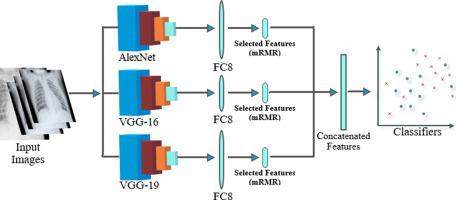IRBM ( IF 5.6 ) Pub Date : 2019-11-06 , DOI: 10.1016/j.irbm.2019.10.006 M. Toğaçar , B. Ergen , Z. Cömert , F. Özyurt

|
Pneumonia is one of the diseases that people may encounter in any period of their lives. Approximately 18% of infectious diseases are caused by pneumonia. This disease may result in death in the following stages. In order to diagnose pneumonia as a medical condition, lung X-ray images are routinely examined by the field experts in the clinical practice. In this study, lung X-ray images that are available for the diagnosis of pneumonia were used. The convolutional neural network was employed as feature extractor, and some of existing convolutional neural network models that are AlexNet, VGG-16 and VGG-19 were utilized so as to realize this specific task. Then, the number of deep features was reduced from 1000 to 100 by using the minimum redundancy maximum relevance algorithm for each deep model. Accordingly, we achieved 100 deep features from each deep model, and we combined these features so as to provide an efficient feature set consisting of totally 300 deep features. In this step of the experiment, this feature set was given as an input to the decision tree, k-nearest neighbors, linear discriminant analysis, linear regression, and support vector machine learning models. Finally, all models ensured promising results, especially linear discriminant analysis yielded the most efficient results with an accuracy of 99.41%. Consequently, the results point out that the deep features provided robust and consistent features for pneumonia detection, and minimum redundancy maximum relevance method was found a beneficial tool to reduce the dimension of the feature set.
中文翻译:

结合mRMR特征选择和机器学习模型的肺炎检测深度特征学习模型
肺炎是人们一生中可能遇到的疾病之一。大约18%的传染病是由肺炎引起的。该疾病可能导致以下阶段的死亡。为了将肺炎诊断为医学病,在临床实践中,通常由现场专家检查肺部X射线图像。在这项研究中,使用了可用于诊断肺炎的肺部X射线图像。使用卷积神经网络作为特征提取器,并利用现有的一些卷积神经网络模型AlexNet,VGG-16和VGG-19来实现此特定任务。然后,通过对每个深度模型使用最小冗余最大相关性算法,将深度特征的数量从1000个减少到100个。因此,我们从每个深度模型中获得了100个深度特征,并结合了这些特征,从而提供了一个有效的特征集,该特征集总共包含300个深度特征。在实验的这一步中,此功能集是作为决策树的输入给出的,k最近邻,线性判别分析,线性回归和支持向量机学习模型。最后,所有模型都确保了有希望的结果,尤其是线性判别分析以99.41%的准确度产生了最有效的结果。因此,结果表明,深层特征为肺炎检测提供了鲁棒且一致的特征,而最小冗余最大相关性方法被认为是减小特征集尺寸的有益工具。











































 京公网安备 11010802027423号
京公网安备 11010802027423号